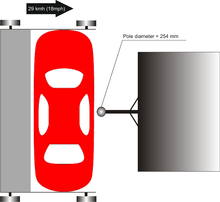- Euro NCAP
-
The European New Car Assessment Programme (Euro NCAP) is a European car safety performance assessment programme based in Brussels (Belgium) and founded in 1997 by the Transport Research Laboratory for the UK Department for Transport and backed by several European governments.[1]
Contents
History and activities
Euro NCAP is a voluntary vehicle safety rating system which originated in the UK but is now backed by the European Commission, seven European governments, as well as motoring and consumer organisations in every EU country.[2][3]
Euro NCAP is modelled after the New Car Assessment Program (NCAP), introduced 1979 by the U.S. National Highway Traffic Safety Administration.[4] Other areas with similar (but not identical) programmes include Australia and New Zealand with ANCAP, Latin America with Latin NCAP and China with C-NCAP.[5]
Euro NCAP publishes safety reports on new cars, and awards 'star ratings' based on the performance of the vehicles in a variety of crash tests, including front, side and pole impacts, and impacts with pedestrians. The top overall rating is five stars.
The frontal tests are performed at 64 km/h (40 mph) into an offset deformable barrier. This is designed to represent an impact with a vehicle of similar mass and structure as the car itself.[6] The side impact tests are performed at 50 km/h (31 mph), but the side impact pole test is performed at 29 km/h (18 mph). The pedestrian safety tests are performed at 40 km/h (25 mph).
Euro NCAP adopted the rear-impact (whiplash) test as part of its new crash-test regime from January 1, 2009. This new rating system also focused more of the overall score on pedestrian protection; Euro NCAP were concerned that car manufacturers were too fixed on occupant safety rather than the safety of those outside the vehicle. Results of the first cars to be tested under the new scheme were released in February 2009.
Over the years, European automakers' cars have become much safer, partly as a result of the Euro NCAP standards. Test results are commonly presented by motor press, and in turn greatly influence consumer demand for a vehicle. One notable example of this is the Rover 100, which after receiving a one-star Adult Occupant Rating in the tests in 1997, suffered from poor sales and was withdrawn from production soon afterwards.[7] BMW's 2007 MINI, for example, had its bonnet (hood) and headlamp fixture changed to meet the latest pedestrian safety requirements.[8]
Euro NCAP testing is not mandatory, with vehicle models either being independently chosen by Euro NCAP or voluntarily tested by the manufacturers.[9] In Europe, new cars are certified as legal for sale under the Whole Vehicle Type Approval regimen that differs from Euro NCAP. According to Euro NCAP,[10] "The frontal and side impact crash tests used by Euro NCAP are based on those used in European legislation. However, much higher performance requirements are used by Euro NCAP. The frontal impact speed used by Euro NCAP is 64 km/h compared 56 km/h for legislation." Euro NCAP also states that "Legislation sets a minimum compulsory standard whilst Euro NCAP is concerned with best possible current practice. Progress with vehicle safety legislation can be slow, particularly as all EU Member States’ views have to be taken into account. Also, once in place, legislation provides no further incentive to improve, whereas Euro NCAP provides a continuing incentive by regularly enhancing its assessment procedures to stimulate further improvements in vehicle safety."
Comparing test results
The Euro NCAP frontal impact tests simulates crashing a car into another of similar mass and structure. This means that the ratings can only be meaningfully compared between cars of the same type and size.[6] The following structural categories are used:
- Passenger car
- MPV
- Off-roader
- Roadster
- Pickup
In each category, cars which are within 150 kg of one another are considered comparable.[6]
See also
General
- Automobile safety rating
- Car classification
- Car safety
- Road safety
Safety organisations
- Latin NCAP
- Transport Research Laboratory
- World Forum for Harmonization of Vehicle Regulations
- Australasian New Car Assessment Program
- National Highway Traffic Safety Administration
- Insurance Institute for Highway Safety
References
- ^ Pernille Larsen (2011-05-25). "FIA Region I . Euro NCAP's standard set for upcoming electric and range-extender cars". Fiabrussels.com. http://www.fiabrussels.com/en/fia_european_bureau/news/euro_ncaps_standard_set_for_upcoming_electric_and_range-extender_cars.htm. Retrieved 2011-11-02.
- ^ "About us: Introduction". Euro NCAP. http://www.euroncap.com/about.aspx.
- ^ "Euro NCAP members". Euro NCAP. http://www.euroncap.com/members.aspx.
- ^ "The New Car Assessment Program Suggested Approaches for Future Program Enhancements" (PDF). National Highway Traffic Safety Administration. January 2007. http://www.safercar.gov/staticfiles/DOT/safercar/pdf/810698.pdf. Retrieved 2008-11-24.
- ^ "What’s C-NCAP?". C-NCAP. January 2007. http://www.c-ncap.org.cn/picen/encontent/what.htm. Retrieved 200-05-18.
- ^ a b c "Comparable cars". Euro NCAP. http://www.euroncap.com/Content-Web-Page/0f3bec79-828b-4e0c-8030-9fa8314ff342/comparable-cars.aspx. Retrieved 2009-08-12.
- ^ "TEN YEARS OF CRASHING NEW CARS". racfoundation.org. http://www.racfoundation.org/index.php?option=com_content&task=view&id=327&Itemid=0. Retrieved 2008-01-26.
- ^ "Exclusive first drive of the refreshed British small car". edmunds.com. http://www.edmunds.com/insideline/do/Features/articleId=116748. Retrieved 2008-01-26.
- ^ "Cars chosen for testing". euroncap.com. http://www.euroncap.com/Content-Web-Faq/5076ae48-c23c-4933-ad63-0449b3a6425b/cars-chosen-for-testing.aspx. Retrieved 2010-07-19.
- ^ "General questions about Euro NCAP". Euro NCAP. http://www.euroncap.com/Content-Web-Faq/b012b7f3-44f9-4755-94f9-a8642fd1402a/about-euro-ncap.aspx.
External links
Categories:- Car safety
Wikimedia Foundation. 2010.





